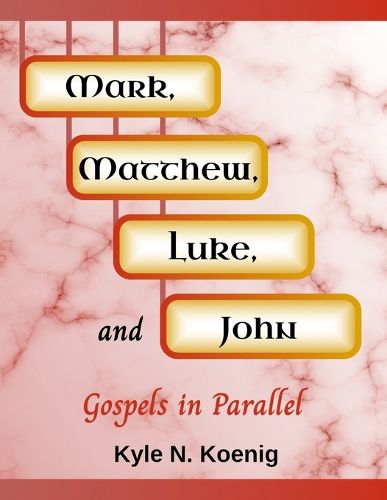Readings Newsletter
Become a Readings Member to make your shopping experience even easier.
Sign in or sign up for free!
You’re not far away from qualifying for FREE standard shipping within Australia
You’ve qualified for FREE standard shipping within Australia
The cart is loading…






This title is printed to order. This book may have been self-published. If so, we cannot guarantee the quality of the content. In the main most books will have gone through the editing process however some may not. We therefore suggest that you be aware of this before ordering this book. If in doubt check either the author or publisher’s details as we are unable to accept any returns unless they are faulty. Please contact us if you have any questions.
The four Gospels (Mark, Matthew, Luke, and John) in the Bible's New Testament cover the stories of Jesus' life, however, they are known to contain variations of those stories. Some variations are simply alternative words or rephrased sentences that retain the thought and meaning of the text between Gospels. Other variations, however, have the appearance of introducing changes to the subject content of those shared stories. This book groups verses from the four Gospels according to story sections and arranges them in a side-by-side format. This layout allows the reader to compare and contrast the differently worded story versions as written by the authors of the four Gospels. The grouped stories are ordered to follow the general timeline of Jesus' life: birth, teaching, death, and resurrection. The Gospels of Mark, Matthew, and Luke on several occasions share identical, or nearly identical, segments of story text. The similarly worded text between the first three Gospels is referred to as being synoptic or "together seeing" because the Gospel authors seemingly either borrowed text from one another or had access to common original witness writings. This book identifies the instances of synoptic text sharing. The contents of this book are part of a modern day rendition of the New Testament. Archaic words, spellings, and sentence phrasings have been translated to more closely match the modern English language characteristics and sentence structure used today.
$9.00 standard shipping within Australia
FREE standard shipping within Australia for orders over $100.00
Express & International shipping calculated at checkout
This title is printed to order. This book may have been self-published. If so, we cannot guarantee the quality of the content. In the main most books will have gone through the editing process however some may not. We therefore suggest that you be aware of this before ordering this book. If in doubt check either the author or publisher’s details as we are unable to accept any returns unless they are faulty. Please contact us if you have any questions.
The four Gospels (Mark, Matthew, Luke, and John) in the Bible's New Testament cover the stories of Jesus' life, however, they are known to contain variations of those stories. Some variations are simply alternative words or rephrased sentences that retain the thought and meaning of the text between Gospels. Other variations, however, have the appearance of introducing changes to the subject content of those shared stories. This book groups verses from the four Gospels according to story sections and arranges them in a side-by-side format. This layout allows the reader to compare and contrast the differently worded story versions as written by the authors of the four Gospels. The grouped stories are ordered to follow the general timeline of Jesus' life: birth, teaching, death, and resurrection. The Gospels of Mark, Matthew, and Luke on several occasions share identical, or nearly identical, segments of story text. The similarly worded text between the first three Gospels is referred to as being synoptic or "together seeing" because the Gospel authors seemingly either borrowed text from one another or had access to common original witness writings. This book identifies the instances of synoptic text sharing. The contents of this book are part of a modern day rendition of the New Testament. Archaic words, spellings, and sentence phrasings have been translated to more closely match the modern English language characteristics and sentence structure used today.